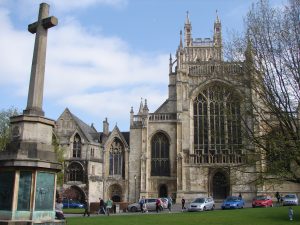In my last two blog postings I have talked about secular and monastic cathedrals in England. Today, I want to discuss other medieval monastic churches which only became cathedrals after King Henry VIII dissolved the monasteries. These are called cathedrals of the new foundation which did not happen until centuries after the Lady Apollonia’s time. One of these medieval monasteries plays a significant role in Memento Mori, the 3rd of Lady Apollonia’s West Country Mysteries.
I am referring to the Abbey of Saint Peter in Gloucester. The church, the Abbot’s House, and the infirmary are important in my story, but in the fourteenth century, the city of Gloucester was not in a separate diocese. It was in the medieval Diocese of Worcester.
The Diocese of Gloucester was carved out of the Diocese of Worcester in the 16th century. The church and the Abbot’s House are today part of Gloucester Cathedral while the infirmary is now reduced to some ruined arches. The surviving cloister is an early example of elegant fanned vaulting and in recent years was used as the setting for some scenes in the early Harry Potter movies. Other cathedrals of the new foundation are found in Bristol, Chester, Oxford, and Peterborough.
The west front of Gloucester Cathedral is pictured below with the Abbot’s Lodging, which also plays a role in Memento Mori, just to the left of the church.
Tags: Chaucer's England, historical fiction, medieval mysteries